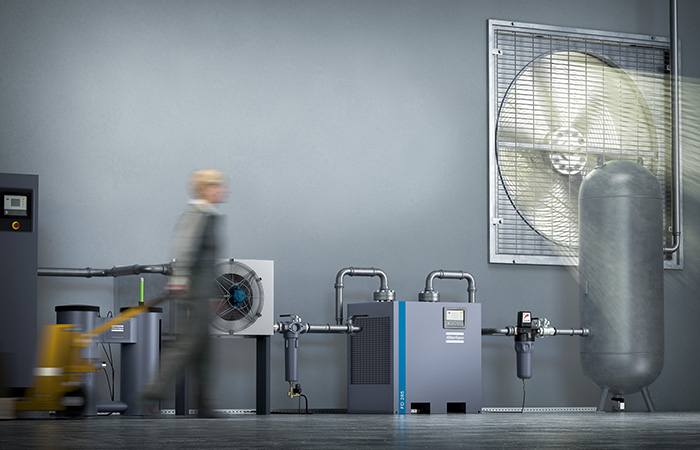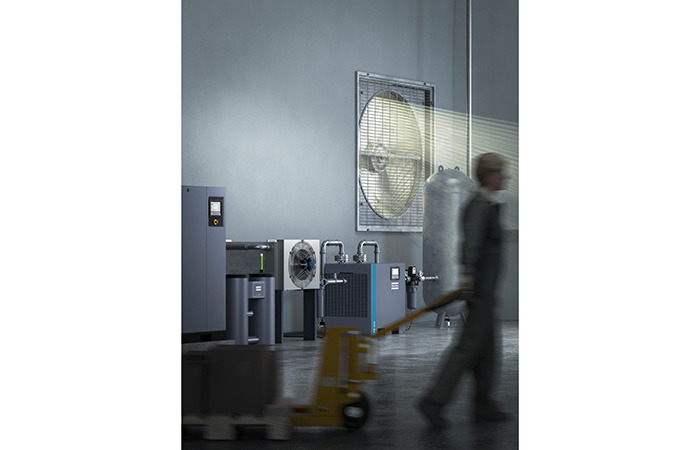
Not all compressor users are fully aware that the production of condensate from the air compression process can lead to excessive moisture and contaminants in the compressed air supply. These are by-products that could jeopardise operational equipment and procedures, but which are also subject to stringent environmental laws related to their safe disposal.
Andy Lill, Business Development Manager - Quality Air, explains the physical laws that create condensate, identifies its hazards, advises on the practical solutions enabling users to manage it at source and, finally, explains how to comply fully with the legal requirements concerning its removal from the compressed air system installation site.
Water in the air
The main constituent of condensate released from an oil-injected compressor is water containing minute particles of oil and microscopic contaminants in suspension. The first question that comes to mind is: ‘Where does the water come from?’
Inlet air at atmospheric pressure contains moisture, but the volume of water produced by an air compressor is largely dependent on the inlet condition, the temperature of the ambient air in a given environment, and the required application pressure.
Pressure dew point (PDP) is the conventional way to measure the water content in compressed air. This is the temperature at which air or gas is saturated with water and begins the process of condensation, or turning into a liquid state − the point at which air is not able to hold any more water vapour.
It’s all about compressibility. A simplistic illustration is that of a water-filled sponge which, when it is squeezed and reduced in volume, has no room for the water. A compressor that works with 7 bar(e) overpressure compresses air to seven-eighths of its volume. This also reduces the air’s ability to hold water vapour by seven-eighths. The quantity of water/condensate that is released as a result is surprisingly large − a 100 kW compressor, drawing in ambient air at 20°C and 60% relative humidity, will produce approximately 85 litres of water during an eight-hour shift.
In comparison, hot and humid air will have a higher moisture content than cold air, and in this type of environment the compressor will produce a correspondingly greater volume of condensate. For example, a 55 kW (75 HP) rotary screw air compressor, operating in 24°C (75°F) ambient temperature with 75% relative humidity, will produce 280 litres (75 gallons) of water per day. Managing this volume of condensate water involves removing it from the compressed air system and, equally important, removing it responsibly from the installation site.
Problems of excessive moisture
There are good reasons for removing excessive moisture from the system. Water in compressed air can have damaging effects on the facility and the effectiveness of process operations. Untreated condensation in compressed air can damage or affect the performance of items such as pneumatic systems, air motors and valves, as well as any components or machines connected to the system. And there is always the risk of contaminating the end product’s manufacturing process.

One of the first steps in removing moisture from the compressed air flow occurs inside most modern compressors where the air, hot after compression at 70–200°C, passes through an aftercooler to lower the temperature and reduce the water content. Then, ideally, it passes on through a water separator where, with the right choice and sizing of the unit, about 80–90% of the water can be removed.
In most compressor installations, the remaining water flows with the compressed air as water mist into an air receiver. Utilising an air receiver can also aid in reducing water content in compressed air, as the vessel is cooled by the tank’s ambient temperature is much cooler than the hot compressed air coming out of the compressor. But it is important to note that a wet tank collects excess moisture too, and must be drained frequently to avoid corrosion and excessive wear.
Separating oil and water
The condensate, as well as its collection, can be complex and expensive. But a cost-effective solution to this problem involves installing an oil/water separator to produce clean water and separate the oil off into a special receiver.
With no moving parts, oil water separators require only minimal maintenance and can handle a wide range of discharge problems, even with heavily contaminated systems. There are also drain valves, which provide completely automatic drainage of the condensate that collects – in filter bowls, aftercoolers and refrigerant dryers - at the bottom of an air receiver. Electronically controlled, they can monitor condensate build-up with liquid level sensors and evacuate the condensate only when necessary, to avoid wasting compressed air.
Staying within the law
New and more stringent laws are continuously being introduced to control the handling of environmentally hazardous waste. Therefore, anyone who runs a compressed air system (using oil-injected technology) must be aware of how to properly dispose of the condensate in a responsible manner to comply with these laws. Not only is incorrect disposal detrimental to the environment, but companies could also incur up to £20,000 in fines and damage to their reputation as a responsible organisation.
To ensure compressor users stay on the right side of the law, plant managers are encouraged to make a visual inventory check of their compressor system installation. A walk-through inspection should reveal the condensate drains at the rear of the compressors, dryers, filters and wet air receivers on the site. Look at where these are piped to – ideally, they should be going to an oil/water separator. If this is the case, the treated condensate can be drained away without damaging the environment or infringing water pollution regulations, as long as the site has a consent to discharge notice supplied by their local water authority. The treated condensate can then be piped into the foul water drain and not the rain water or storm water drain.
If the condensate is going straight from a drain onto the floor, or just into a standard plastic container, there is a need for action. Oil/water separators are very easy to install and operate. But, a note of caution: when it comes to the disposal of condensate, even with the correct equipment in place, the rules can vary from region to region, so it pays to be fully conversant with their specific application to an individual site. Companies must have a Permit to Discharge or an exemption from the Environment Agency before any disposal procedure takes place.
For further advice and guidance on condensate management, contact your compressed air system supplier.










National Gas receives funding to develop Gravitricity underground hydrogen storage system
One single rock salt mine - Winsford - has 23 <i>MILLION </i>cubic metres of void and even allowing for 10% of that void set aside for hazardous waste...